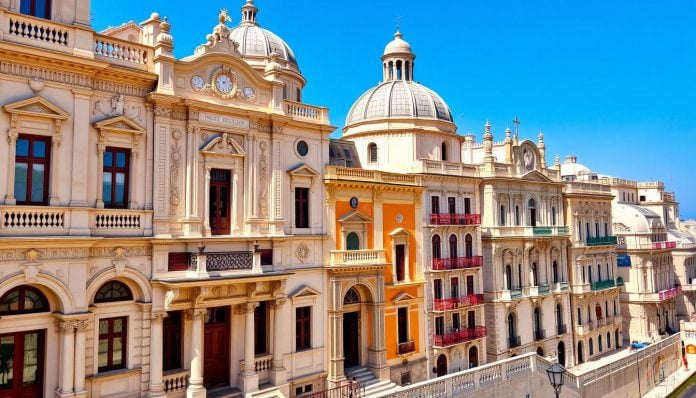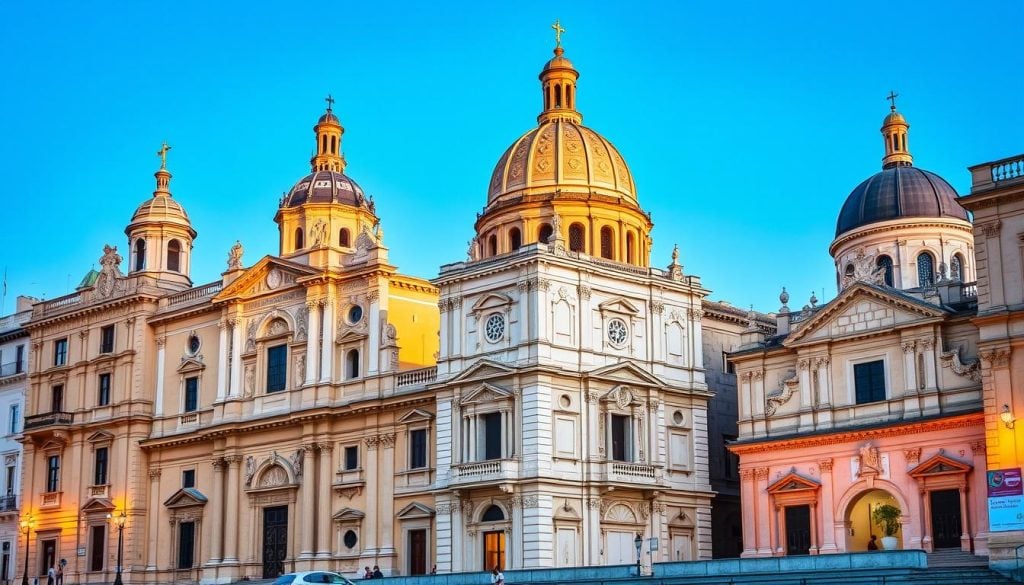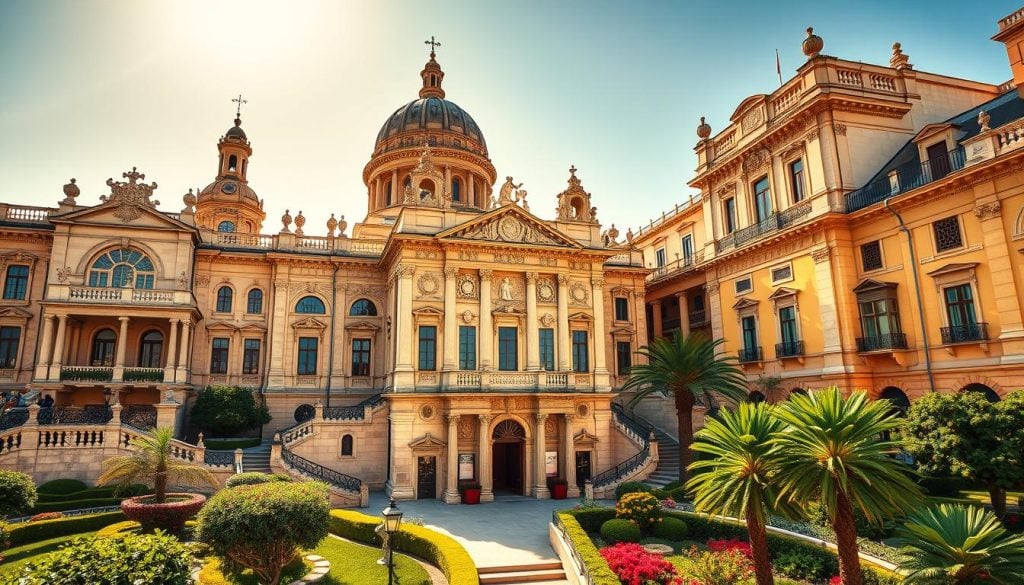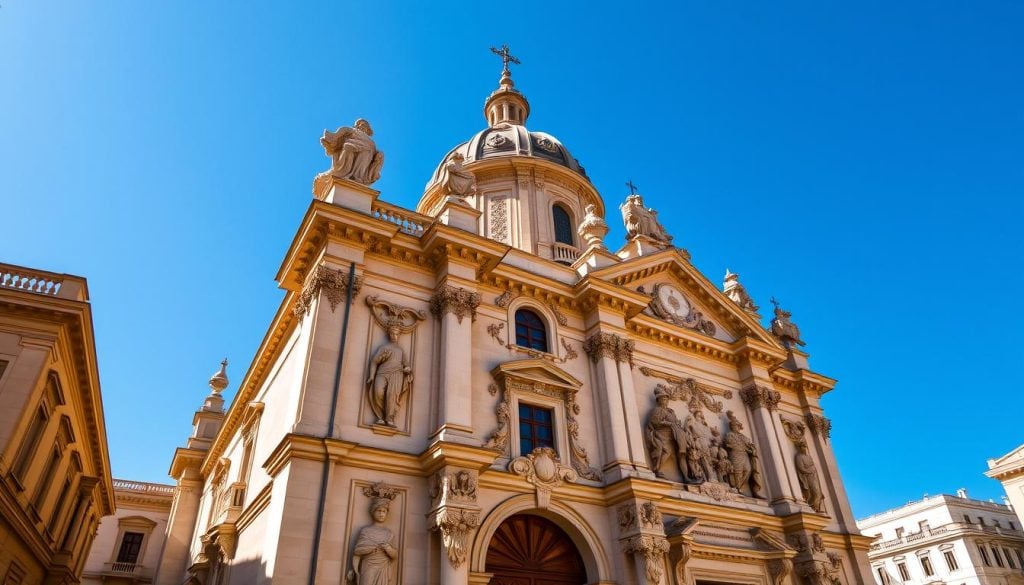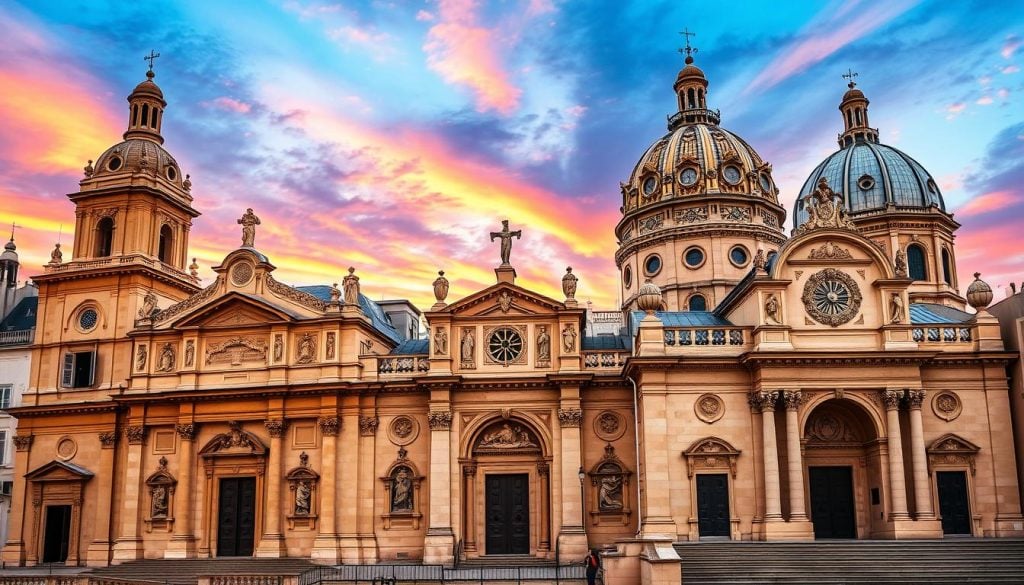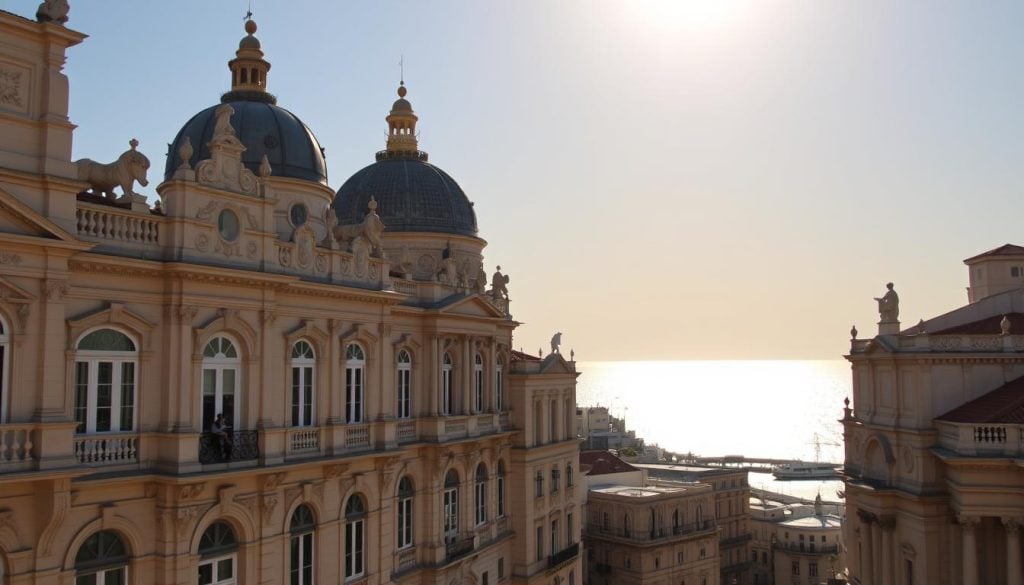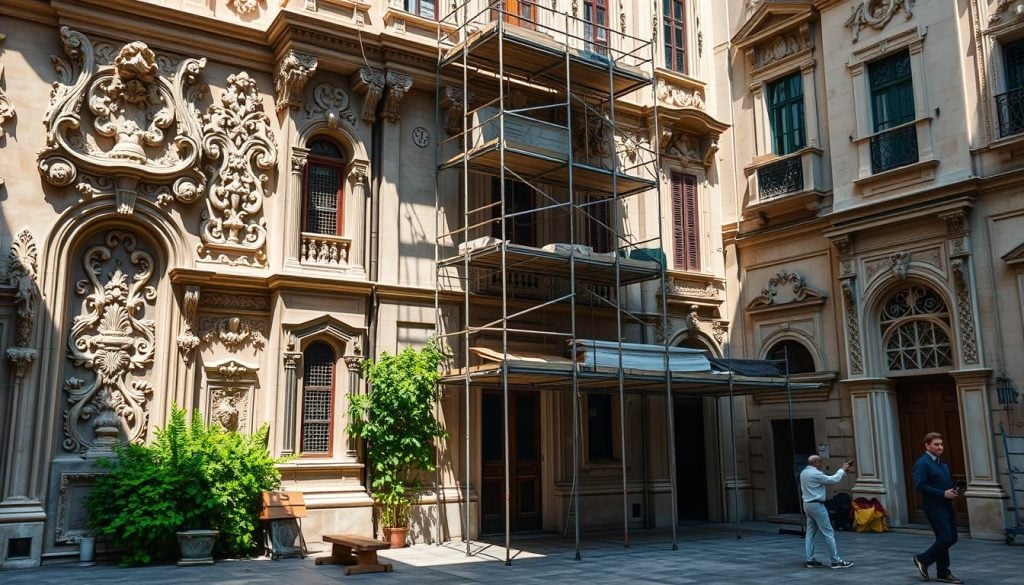Have you ever wondered how a city can mix history, art, and architecture so well? Valletta, Malta, is a perfect example. It’s known for its Baroque architecture and rich cultural heritage. This was all thanks to the Knights of St. John.
This architectural wonder bloomed in the 17th and 18th centuries. It amazes visitors with its detailed designs and grand scale.
Walking through Valletta’s streets, you’ll learn about its architectural wonders. These buildings tell the story of its lively past. They also show how the city’s identity has been shaped over time.
Join us as we explore the secrets of Valletta’s architectural heritage. It’s a journey into the heart of this enchanting city.
Introduction to Baroque Architecture in Malta
Baroque architecture in Malta started in the early 17th century. It marked a big change from the Mannerist style before it. This style is known for its detailed decorations and how it uses light and shadow.
The Knights of St. John brought Baroque to the islands. They built many landmarks that show off this style. These buildings are grand and full of beauty.
The Valletta cityscape is full of Baroque style buildings. Their bright colors and detailed designs draw people in. These buildings changed Malta’s look and gave it a unique identity.
These buildings show the power and prestige of the Knights. They reflect the values of that time. It’s a glimpse into the past.
The Arrival of Baroque Style in Valletta
The Baroque style arrived in Valletta, changing the city’s art and buildings. In the early 1600s, architects like Bontadino de Bontadini started big projects. The Wignacourt Aqueduct was one of them.
This change brought new Baroque designs to Valletta. It moved away from Mannerism to more detailed and grand Baroque styles.
Many important people helped shape Valletta’s buildings. The Baroque style used space in a dramatic way. It had detailed designs and showed power and creativity.
Walking through Valletta, you’ll see these styles in the buildings. They show the values and dreams of that time. This mix of art and architecture has made Valletta a key part of Malta’s history.
Signature Features of Baroque Architecture Valletta
Baroque architecture in Valletta is known for its grandeur and detailed artistry. You can see the unique elements that make this style stand out. The key features of Baroque art in Valletta are evident in the elaborate façades and the careful details. These elements tell a story of artistic brilliance and cultural importance.
Elaborate Facades and Sculptural Details
The Baroque architecture in Valletta is mesmerizing, with dynamic shapes and intricate ornamentation. Each building has ornate façades that draw you in, with sculptural details that capture the essence of the Baroque period. These artistic decorations often include:
- Grand entranceways that draw the eye.
- Reliefs that depict historical and religious narratives.
- Balustrades and columns that enhance the structural sophistication.
Exploring the city, you’ll see how these elaborate features create a stunning visual experience. This experience represents Valletta’s rich heritage.
Use of Locally Sourced Limestone
Locally sourced limestone is another key feature of Baroque architecture in Valletta. This material makes the structures durable and showcases the region’s natural resources. The qualities of this limestone include:
- Warm, golden hues that reflect sunlight beautifully.
- Ease of carving, allowing artisans to create detailed sculptures.
- Resistance to weathering, ensuring longevity of the buildings.
The use of locally sourced limestone in the design of these structures enhances the beauty of Baroque art in Valletta. It allows visitors to see the skill and craftsmanship in every architectural masterpiece.
The Influence of the Knights of St. John
The Knights of St. John greatly influenced Valletta’s architecture. They built many important structures, blending military and religious styles. This mix defined Valletta’s unique character.
Impact on Valletta’s Architectural Landscape
The Knights’ vision went beyond building defenses. They created grand public spaces, palaces, and churches. This mix of styles made Valletta’s architecture rich and beautiful. The city’s buildings, with their detailed designs, still impress people today.
Major Contributions of the Grand Masters
Grand Masters of Malta were key in building Valletta’s landmarks. Leaders like Manuel Pinto da Fonseca led the construction of major buildings. Their work made Valletta famous for its Baroque architecture, linking the city’s culture to the Knights’ history.
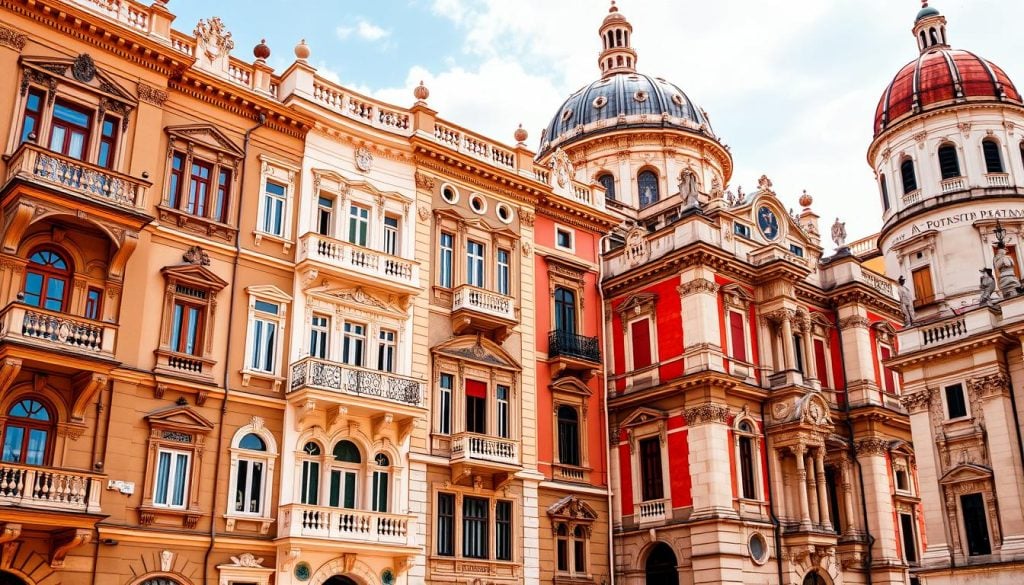
Notable Baroque Churches in Valletta
Valletta is filled with Baroque architecture, showcasing several churches. The St. John’s Co-Cathedral stands out, showing off the beauty and importance of Baroque churches in Malta. Each church adds to Valletta’s rich history and stunning architecture.
St. John’s Co-Cathedral: A Marvel of Baroque Art
The St. John’s Co-Cathedral was finished in 1577. It boasts incredible interior decorations and artwork. Visitors from all over come to see its ornate chapels and frescoed ceilings.
Artists like Mattia Preti have left their mark here. This makes the cathedral a key part of Baroque art history. It shows the skill and creativity of its makers.
Other Important Baroque Churches in Valletta
Valletta is home to more than just St. John’s Co-Cathedral. Other churches also show off the Baroque style:
- Church of St. Paul’s Shipwreck: Famous for its colorful artwork and detailed altar.
- Church of St. Teresa of Avila: Known for its intricate details and beautiful façade.
- Church of Our Lady of Mount Carmel: It’s famous for its unique architecture and peaceful vibe.
Visiting these Baroque churches in Malta helps us appreciate Valletta’s architectural diversity and cultural richness.
Key Baroque Buildings in Valletta
Valletta’s architecture is filled with key Baroque buildings. These show the city’s rich history and artistic heritage. The Auberge de Castille and the Grandmaster’s Palace are two standout structures.
They highlight the grandeur of Baroque architecture in Valletta. They show the mastery and style of this period.
Auberge de Castille: A Monumental Masterpiece
The Auberge de Castille was designed by Andrea Belli. Its façade is a stunning example of Baroque architecture’s opulence. The building’s intricate details and stately presence make it a key part of Valletta’s architecture.
Originally, it was the Knights of St. John’s residence. Over the years, it has seen changes but still keeps its Baroque charm.
The Grandmaster’s Palace: A Historical Gem
The Grandmaster’s Palace is a significant historical site. It was built for the Order of St. John. Its impressive interiors and symbolic importance show the Knights’ power and influence.
Visitors to Valletta must see this palace. It is one of the essential Baroque buildings in the city.
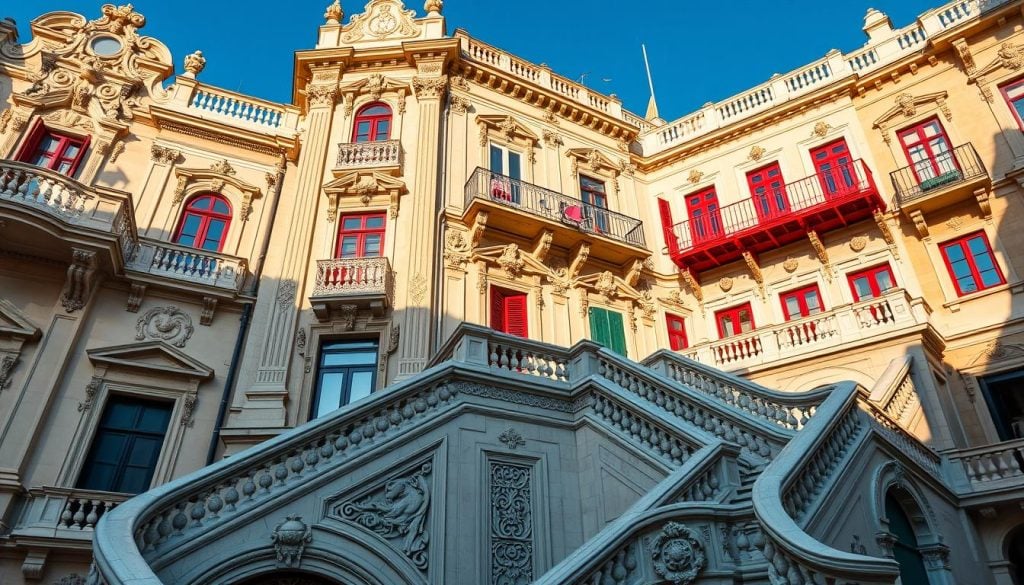
| Building | Architectural Highlights | Historical Significance |
|---|---|---|
| Auberge de Castille | Intricate façade and grand entrance | Residence of the Knights of St. John |
| Grandmaster’s Palace | Stately architecture and ornate interiors | Administrative center for the Knights |
UNESCO World Heritage Status of Valletta
The UNESCO World Heritage Site Valletta is a symbol of the city’s architectural heritage and history. It’s known for its stunning Baroque architecture. This highlights the city’s well-kept urban layout and strong fortifications.
This city shows the artistic skill of its time. It also shows how buildings were made to fit local needs and environments. To get this status, the city must have great cultural value, be true to its past, and keep its urban fabric intact. Every part of the city shares a piece of its rich history, from its streets to its monuments.
Efforts to keep the Valletta architectural heritage alive are ongoing. This lets future generations see the city’s beauty. These efforts include detailed restoration work, raising public awareness, and working with global groups focused on saving heritage.
- Significant criteria for UNESCO recognition:
- Outstanding universal value
- Integrity of structures
- Preservation of cultural landscapes
- Conservation methods in place:
- Restoration of historical buildings
- Community involvement in heritage preservation
- Partnerships with global institutions
Baroque Architecture Valletta: Preservation and Conservation Efforts
Keeping Valletta’s Baroque architecture alive is key to its rich history and culture. Many efforts are underway to restore and protect these stunning buildings. They use new methods and involve the community to ensure the Baroque heritage of Valletta endures for years to come.
Modern Initiatives to Restore Historical Sites
Restoration projects in Valletta aim to make historical sites more accessible. They also work hard to keep their original look and feel. The projects include:
- Checking the buildings’ strength.
- Using old materials for repairs.
- Getting the community involved in conservation.
- Teaching people about the importance of preserving Baroque architecture.
These efforts show how important community involvement is. They prove that by raising awareness, we can better protect our heritage. The main goal is to keep Valletta’s Baroque wonders safe for future generations to enjoy.
| Project Name | Description | Status |
|---|---|---|
| St. John’s Co-Cathedral Restoration | Targeted repairs and cleaning of the facade and interior. | Ongoing |
| Auberge de Castille Renovation | Revitalization of structural elements and gardens. | Completed |
| The Grandmaster’s Palace Upgrade | Installation of modern visitor facilities while maintaining historical aesthetics. | Upcoming |
Thanks to these hard efforts, Valletta’s Baroque architecture is thriving. These historical treasures will continue to be a lively part of the city’s culture.
Conclusion
The Baroque architecture in Valletta is a mix of history, art, and culture. As you walk through the city, you see how the Knights of St. John left their mark. Each building tells a story of Malta’s past.
Valletta is a feast for the eyes and a must-see for history lovers. Being a UNESCO World Heritage Site, it’s vital to keep its beauty alive. This way, future generations can enjoy its stunning Baroque architecture.
Your trip to Valletta will make you appreciate Baroque architecture more. You’ll see how it shapes the city’s beauty. It’s a journey into Valletta’s rich cultural history.

































